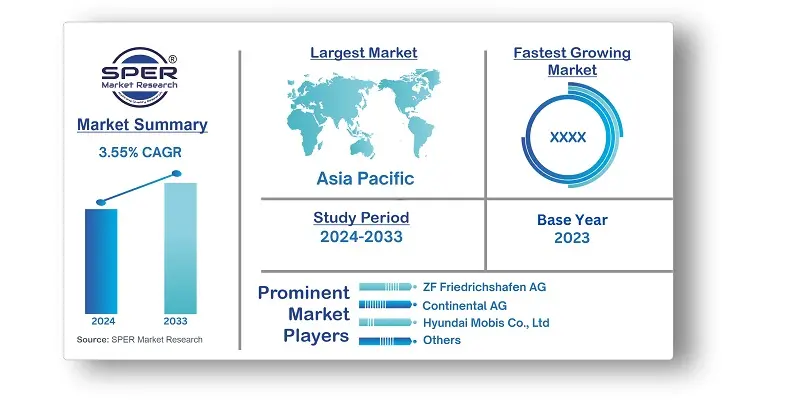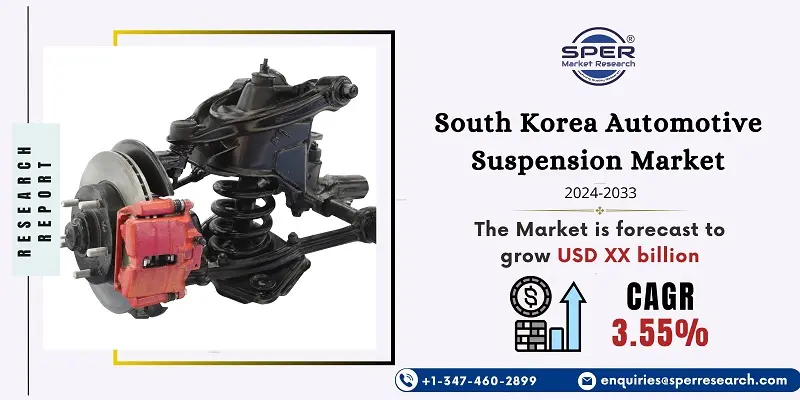
South Korea Automotive Suspension Market Trends, Share, Demand, Revenue and Future Outlook
South Korea Automotive Suspension Market Growth, Size, Trends Analysis– By System, By Suspension Type, By Component, By Vehicle Type- Regional Outlook, Competitive Strategies and Segment Forecast to 2033
| Published: Oct-2024 | Report ID: AMIN24215 | Pages: 1 - 108 | Formats*: |
| Category : Automotive & Transportation | |||
- Sono Motors debuted its Solar Powered Electric Vehicle in December 2022, which features a MacPherson suspension system.
- BMW and ZF collaborated in August 2022 to design a carbon fibre suspension for the K 1600 GT Duolever. The lightweight material would help BMW decrease weight and study the performance of their superbike, the M 1000 RR.
- August 2022 - Vibracoustic created a low-cost ride height and suspension levelling technology. The method enables car manufacturers to reap the height-leveling benefits of an air suspension with less complexity and expense.


| Report Metric | Details |
| Market size available for years | 2020-2033 |
| Base year considered | 2023 |
| Forecast period | 2024-2033 |
| Segments covered | By System, By Suspension Type, By Component, By Vehicle Type. |
| Regions covered | Seoul Capital Area, Yeongnam (Southeastern Region), Honam (Southwestern Region), Hoseo (Central Region). |
| Companies Covered | Mando Corp, HYUNDAI TRANSYS Inc, Hyundai Mobis Co., Ltd, ZF Friedrichshafen AG, Continental AG, ThyssenKrupp AG, Marelli Holdings Co., Ltd, Benteler International AG. |
- Automotive Manufacturers
- Suspension System Suppliers
- Automotive OEMs (Original Equipment Manufacturers)
- Aftermarket Suspension Providers
- Vehicle Component Distributors
- Automotive Repair and Service Centers
- Regulatory Authorities
- Research and Development Institutions
- Automotive Dealerships
| By System: | |
| By Suspension Type: | |
| By Component: | |
| By Vehicle Type: |
- South Korea Automotive Suspension Market Size (FY’2024-FY’2033)
- Overview of South Korea Automotive Suspension Market
- Segmentation of South Korea Automotive Suspension Market By System (Passive System, Semi-Active/Active System)
- Segmentation of South Korea Automotive Suspension Market By Suspension Type (Hydraulic Suspension, Air Suspension)
- Segmentation of South Korea Automotive Suspension Market By Component (Spring, Shock Dampener, Air compressor, Struts, Others)
- Segmentation of South Korea Automotive Suspension Market By Vehicle Type (Passenger Vehicle, Two-Wheeler, Commercial Vehicle, Others)
- Statistical Snap of South Korea Automotive Suspension Market
- Expansion Analysis of South Korea Automotive Suspension Market
- Problems and Obstacles in South Korea Automotive Suspension Market
- Competitive Landscape in the South Korea Automotive Suspension Market
- Impact of COVID-19 and Demonetization on South Korea Automotive Suspension Market
- Details on Current Investment in South Korea Automotive Suspension Market
- Competitive Analysis of South Korea Automotive Suspension Market
- Prominent Players in the South Korea Automotive Suspension Market
- SWOT Analysis of South Korea Automotive Suspension Market
- South Korea Automotive Suspension Market Future Outlook and Projections (FY’2024-FY’2033)
- Recommendations from Analyst
1.1. Scope of the report1.2. Market segment analysis
2.1. Research data source
2.1.1. Secondary Data2.1.2. Primary Data2.1.3. SPER’s internal database2.1.4. Premium insight from KOL’s
2.2. Market size estimation
2.2.1. Top-down and Bottom-up approach
2.3. Data triangulation
4.1. Driver, Restraint, Opportunity and Challenges analysis
4.1.1. Drivers4.1.2. Restraints4.1.3. Opportunities4.1.4. Challenges
4.2. COVID-19 Impacts of the South Korea Automotive Suspension Market.
5.1. SWOT Analysis
5.1.1. Strengths5.1.2. Weaknesses5.1.3. Opportunities5.1.4. Threats
5.2. PESTEL Analysis
5.2.1. Political Landscape5.2.2. Economic Landscape5.2.3. Social Landscape5.2.4. Technological Landscape5.2.5. Environmental Landscape5.2.6. Legal Landscape
5.3. PORTER’s Five Forces
5.3.1. Bargaining power of suppliers5.3.2. Bargaining power of buyers5.3.3. Threat of Substitute5.3.4. Threat of new entrant5.3.5. Competitive rivalry
5.4. Heat Map Analysis
6.1. South Korea Automotive Suspension Market Manufacturing Base Distribution, Sales Area, Product Type6.2. Mergers & Acquisitions, Partnerships, Product Launch, and Collaboration in South Korea Automotive Suspension Market
7.1. South Korea Automotive Suspension Market Size, Share and Forecast, By System, 2020-20267.2. South Korea Automotive Suspension Market Size, Share and Forecast, By System, 2027-20337.3. Passive System7.4. Semi-Active/Active System
8.1. South Korea Automotive Suspension Market Size, Share and Forecast, By Suspension Type, 2020-20268.2. South Korea Automotive Suspension Market Size, Share and Forecast, By Suspension Type, 2027-20338.3. Hydraulic suspension8.4. Air suspension
9.1. South Korea Automotive Suspension Market Size, Share and Forecast, By Component, 2020-20269.2. South Korea Automotive Suspension Market Size, Share and Forecast, By Component, 2027-20339.3. Spring9.4. Shock Dampener9.5. Air Compressor9.6. Struts9.7. Others
10.1. South Korea Automotive Suspension Market Size, Share and Forecast, By Vehicle Type, 2020-202610.2. South Korea Automotive Suspension Market Size, Share and Forecast, By Vehicle Type, 2027-203310.3. Passenger Vehicle10.4. Two-Wheeler10.5. Commercial Vehicle10.6. Others
11.1. South Korea Automotive Suspension Market Size and Market Share
12.1. South Korea Automotive Suspension Market Size and Market Share By Region (2020-2026)12.2. South Korea Automotive Suspension Market Size and Market Share By Region (2027-2033)
12.2.1. Seoul Capital Area12.2.2. Yeongnam (Southeastern Region)12.2.3. Honam (Southwestern Region)12.2.4. Hoseo (Central Region)12.2.5. Others
13.1. Mando Corp
13.1.1. Financial outlook13.1.2. Product summary13.1.3. Recent developments
13.2. HYUNDAI TRANSYS Inc
13.2.1. Company details13.2.2. Financial outlook13.2.3. Product summary13.2.4. Recent developments
13.3. Hyundai Mobis Co., Ltd
13.3.1. Company details13.3.2. Financial outlook13.3.3. Product summary13.3.4. Recent developments
13.4. ZF Friedrichshafen AG
13.4.1. Company details13.4.2. Financial outlook13.4.3. Product summary13.4.4. Recent developments
13.5. Continental AG
13.5.1. Company details13.5.2. Financial outlook13.5.3. Product summary13.5.4. Recent developments
13.6. ThyssenKrupp AG
13.6.1. Company details13.6.2. Financial outlook13.6.3. Product summary13.6.4. Recent developments
13.7. Marelli Holdings Co., Ltd
13.7.1. Company details13.7.2. Financial outlook13.7.3. Product summary13.7.4. Recent developments
13.8. Benteler International AG
13.8.1. Company details13.8.2. Financial outlook13.8.3. Product summary13.8.4. Recent developments
13.9. Others
SPER Market Research’s methodology uses great emphasis on primary research to ensure that the market intelligence insights are up to date, reliable and accurate. Primary interviews are done with players involved in each phase of a supply chain to analyze the market forecasting. The secondary research method is used to help you fully understand how the future markets and the spending patterns look likes.
The report is based on in-depth qualitative and quantitative analysis of the Product Market. The quantitative analysis involves the application of various projection and sampling techniques. The qualitative analysis involves primary interviews, surveys, and vendor briefings. The data gathered as a result of these processes are validated through experts opinion. Our research methodology entails an ideal mixture of primary and secondary initiatives.



Frequently Asked Questions About This Report
PLACE AN ORDER
Year End Discount
Sample Report
Pre-Purchase Inquiry
NEED CUSTOMIZATION?
Request CustomizationCALL OR EMAIL US
100% Secure Payment






Related Reports
Our Global Clients
Our data-driven insights have influenced the strategy of 200+ reputed companies across the globe.




















